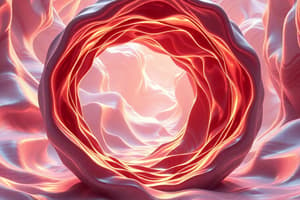Podcast
Questions and Answers
What visual element is commonly featured throughout the images presented?
What visual element is commonly featured throughout the images presented?
- Collages of various landscapes
- Graphs with increasing metrics
- Patterns and textures (correct)
- Detailed drawings of machinery
Which of the following best describes the overall theme of the images?
Which of the following best describes the overall theme of the images?
- Technological advancements in machinery
- Natural elements and their representations
- Artistic explorations of color and form (correct)
- Historical events illustrated graphically
How do the images primarily engage the viewer?
How do the images primarily engage the viewer?
- With visually stimulating aesthetics (correct)
- By presenting factual information
- Through complex narrative storytelling
- Via interactive components and technology
What element in the images might lead to a discussion about cultural significance?
What element in the images might lead to a discussion about cultural significance?
Which aspect of the images could be interpreted as a commentary on modern life?
Which aspect of the images could be interpreted as a commentary on modern life?
Flashcards
Mass
Mass
A measure of how much matter is in an object.
Weight
Weight
The force of gravity acting on an object's mass.
Volume
Volume
The amount of space an object takes up.
Density
Density
Signup and view all the flashcards
Motion
Motion
Signup and view all the flashcards
Study Notes
Module 1: Modelling and Simulation Concepts
- This module is divided into six units
- Unit 1 covers the basics of modelling and simulation
- Unit 2 discusses random numbers
- Unit 3 explores random number generation
- Unit 4 introduces the Monte Carlo method
- Unit 5 delves into statistical distribution functions
- Unit 6 examines common probability distributions
Intended Learning Outcomes (Unit 1)
- Define a model and modelling
- Explain when and why we use models
- Describe the modeling process
- Describe different types of models
Module 1: Main Content (Unit 1)
- Modeling is the process of generating abstract, conceptual, graphical, and/or mathematical representations of real-world or imaginary systems.
- Models are used when the outcome of a particular alternative is uncertain, or when the system has complex interactions.
- Simulation involves manipulating a model to understand its behavior.
Module 1: Definitions
- Model: A representation of a real-world phenomenon or elements
- Simulation: Manipulation of a model in time and/or space
Module 1: Advantages of Using Models
- Models are safer than handling real-world equivalent
- Models are cheaper than real-world counterpart
- Models are more accessible in complex conditions
Module 1: Applications
- Science and engineering
- Modeling and simulation
- Decision making
- Optimizing performance
Unit 1: Modeling and Simulation Concepts
- The ability to define what may happen in the future is crucial to contemporary societies.
- The ways things work in society or nature come with difficulties in predicting outcomes.
- Simulation has helped to reduce the differences between estimated outcomes and reality.
Module 2: Modeling and Simulation Concepts
- This module comprises four units
- Unit 1 covers simulation and modeling.
- Unit 2 details about modeling methods.
- Unit 3 discusses physics-based finite element models.
- Unit 4 examines the use of statistics for modelling and simulation.
Module 2: Intended Learning Outcomes (Unit 1)
- Define what simulation is about.
- Explain why simulation is needed.
- Describe methods used to perform simulation studies.
- Describe different types of simulations.
Studying That Suits You
Use AI to generate personalized quizzes and flashcards to suit your learning preferences.




